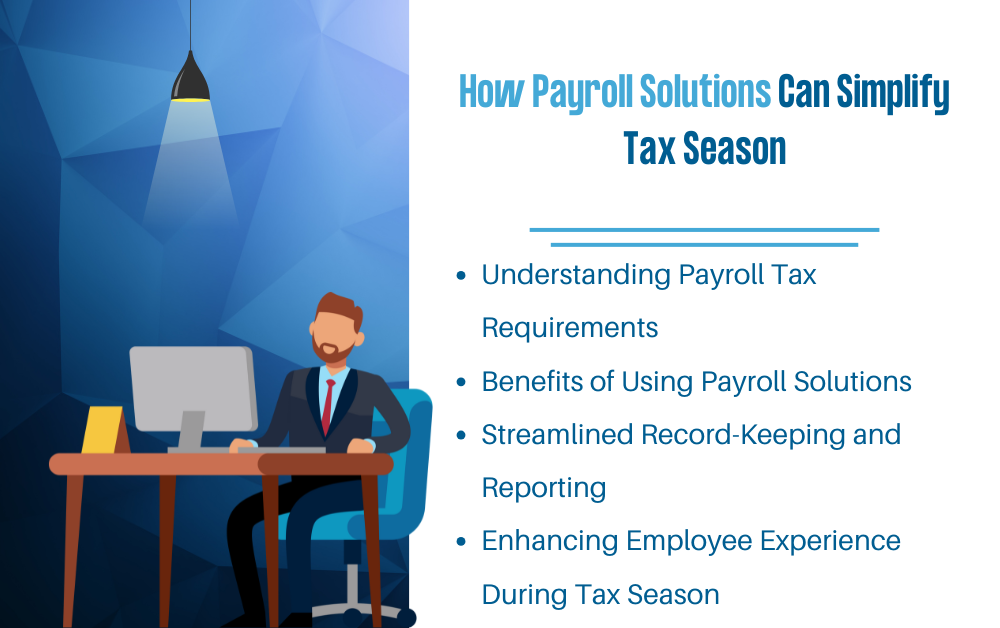blogs
The Best Tenant Screening Services
Imagine a world where every tenant who walks through your property's door is not just a renter,...
Navigating the Complex World of Employee Issues
Maintaining harmony isn't just an ideal in the intricate dance of the workplace—it's an essential...
Simplify Your Hiring Process with New Employee Forms
Are you in the process of expanding your team? Hiring new employees can be an exciting step for...

How Payroll Solutions Can Simplify Tax Season
Tax season can be a stressful time for businesses of all sizes. With numerous tax forms to complete, calculations to verify, and deadlines to meet, many companies find themselves overwhelmed. However, utilizing payroll solutions can significantly simplify this process, ensuring accuracy and compliance while alleviating some of the stress associated with tax preparation.
Understanding Payroll Tax Requirements
Before diving into the benefits of payroll solutions, it’s essential to understand the various types of payroll taxes businesses must manage. Payroll taxes typically include federal, state, and local taxes, each with its own set of requirements. Failing to accurately calculate and remit these taxes can lead to costly penalties and compliance issues. Many businesses struggle with manual payroll processes, leading to common pitfalls such as miscalculations and missed deadlines. This is where robust payroll solutions come into play.
Benefits of Using Payroll Solutions During Tax Season
Automated Calculations
One of the standout features of modern payroll solutions is their ability to automate tax calculations. By automatically calculating federal and state taxes, Social Security, and Medicare contributions, these systems reduce the risk of human error. This automation saves valuable time for payroll administrators, allowing them to focus on other critical aspects of their business.
Easy Generation of Tax Forms
During tax season, businesses must generate several essential forms, such as W-2s for employees and 1099s for independent contractors. Payroll solutions simplify this process by automatically generating these forms based on the data collected throughout the year. This not only streamlines the filing process but also ensures accuracy, as the system pulls the necessary information directly from payroll records. Many payroll solutions also offer electronic filing options, further easing the administrative burden.
Real-Time Updates on Tax Regulations
Tax laws and regulations can change frequently, making it challenging for businesses to stay compliant. Fortunately, many payroll solutions are designed to keep users informed about these changes. By receiving real-time updates on tax regulations, businesses can ensure that their payroll processes align with the latest requirements, minimizing the risk of compliance issues.
Streamlined Record-Keeping and Reporting
Effective record-keeping is crucial during tax season, and payroll solutions excel in this area. These systems maintain accurate records of employee wages, deductions, and tax payments, making it easy to access necessary information when preparing for tax filings. Furthermore, robust reporting features allow businesses to generate reports that summarize payroll data, aiding in both preparation and potential audits. By leveraging the reporting capabilities of payroll solutions, businesses can ensure they have everything in order before tax deadlines.
Enhancing Employee Experience During Tax Season
Access to Pay Stubs and Tax Documents
Another advantage of using payroll solutions is the employee self-service portal feature. Employees can access their pay stubs, tax forms, and other payroll-related documents at any time, promoting transparency and empowering them to take charge of their financial information. This accessibility can improve employee satisfaction, especially during tax season when individuals are often concerned about their tax documents.
Timely Distribution of Tax Forms
With the automation offered by payroll solutions, businesses can ensure that employees receive their tax forms promptly. This timely distribution prevents unnecessary delays and confusion, fostering a positive work environment. When employees feel supported during tax season, it can lead to increased morale and loyalty.
Conclusion
In conclusion, the complexities of tax season can be daunting for any business, but investing in payroll solutions can make the process significantly easier. By automating calculations, simplifying tax form generation, and ensuring compliance with real-time updates, these solutions take the stress out of payroll management during tax time. Additionally, they enhance employee experience through self-service access to important documents and timely distribution of tax forms.
If you’re looking to alleviate the challenges of tax season, consider implementing a payroll solution tailored to your business needs. By doing so, you can streamline your payroll processes and focus on what truly matters: growing your business.
Ready to simplify your tax season? Explore our range of payroll solutions today to find the right fit for your business. Whether you’re a small startup or an established enterprise, we have the tools you need to make tax season a breeze!
